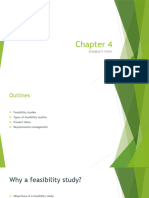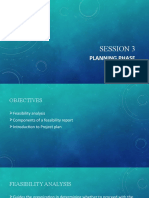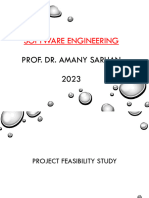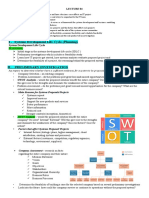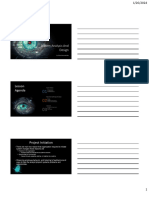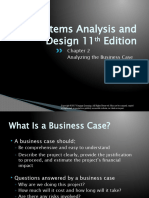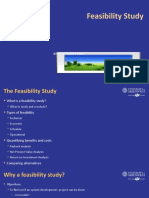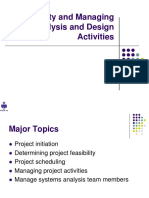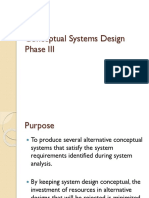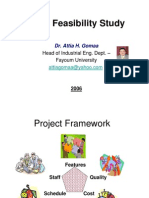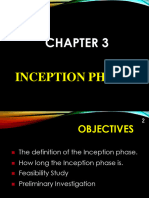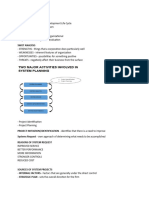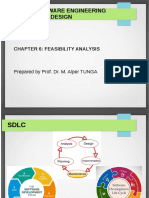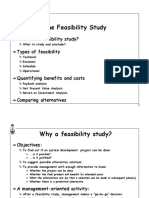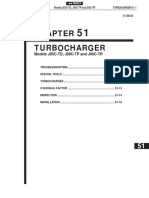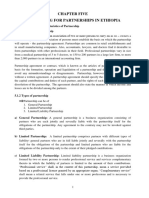Systems Analysis Project Initiation
Fundamentals • Three general driving forces:
Project Initiation • To respond to an opportunity
Project Feasibility
Areas of Feasibility • To resolve a problem
Feasibility Analysis
Work Breakdown Structure • To conform to a directive
PERT/CPM Diagram
Gantt Charts
1 __________________________ 2 _________________________
____________________________ ___________________________
____________________________ ___________________________
____________________________ ___________________________
____________________________ ___________________________
____________________________ ___________________________
____________________________ ___________________________
____________________________ ___________________________
____________________________ ___________________________
Project Feasibility Areas of Feasibility
• During project feasibility, the project manager • Economic Feasibility
answers questions such as, • process of identifying the financial benefits and
• “Are the expected benefits reasonable?” costs associated with a development project
• “Are the assumed costs realistic?” • consists of two tests:
• The objective of project feasibility is to determine • Is the anticipated value of the benefits greater than
whether a development project has a reasonable projected costs of development?
chance of success. • Does the organization have adequate cash flow to
• Feasibility analysis basically identifies all the risks fund the project during the development period?
of failure.
3 __________________________ 4 _________________________
____________________________ ___________________________
____________________________ ___________________________
____________________________ ___________________________
____________________________ ___________________________
____________________________ ___________________________
____________________________ ___________________________
____________________________ ___________________________
____________________________ ___________________________
� Areas of Feasibility Areas of Feasibility
• Cost-benefit analysis is the analysis to compare • Three-step process:
costs and benefits to see whether investing in • Estimate the anticipated development and
the development of a new system will be operational costs
beneficial. • Estimate the anticipated financial benefits
• Cost-benefit analysis is calculated based on the
detailed estimates of costs and benefits
• Costs and benefits can be viewed as:
• Tangible
• Intangible
5 __________________________ 6 _________________________
____________________________ ___________________________
____________________________ ___________________________
____________________________ ___________________________
____________________________ ___________________________
____________________________ ___________________________
____________________________ ___________________________
____________________________ ___________________________
____________________________ ___________________________
Areas of Feasibility Areas of Feasibility
• Three techniques to assess economic feasibility: • The Time Value of Money (TVM) is the
• Net Present Value (NPV) concept applied to each technique, which refers
• Payback Period to the concept of comparing present cash
• Return Of Investment (ROI) outlays to future expected returns.
7 __________________________ 8 _________________________
____________________________ ___________________________
____________________________ ___________________________
____________________________ ___________________________
____________________________ ___________________________
____________________________ ___________________________
____________________________ ___________________________
____________________________ ___________________________
____________________________ ___________________________
� Areas of Feasibility Areas of Feasibility
• Technical Feasibility • Operational Feasibility
• to gain understanding of the organization’s • process of assessing the degree to which a
ability to construct the proposed system proposed system solves business problems or
• should include an assessment of the takes advantage of business opportunities
development group’s understanding of the • measure of how well the solution will work in
possible target hardware, software, and the organization
operating environments to be used as well as • measure of how people feel about the
system size, complexity, and the group’s system/project
experience with similar systems
9 __________________________ 10 ________________________
____________________________ ___________________________
____________________________ ___________________________
____________________________ ___________________________
____________________________ ___________________________
____________________________ ___________________________
____________________________ ___________________________
____________________________ ___________________________
____________________________ ___________________________
Areas of Feasibility Areas of Feasibility
• Schedule Feasibility • Resource Feasibility
• gain understanding of the likelihood that all • requires the involvement of systems analysts,
potential time frames and completion date system technicians, and users
schedules can be met and that meeting these • risk to consider here is that the people who are
dates will be sufficient for dealing with the assigned may not have the essential skills for
needs of the organization the project
• measure of how reasonable the project • Other resources needed for a project to be
timetable is successful include adequate computer
resources, physical facilities, and support staff
11 _________________________ 12 ________________________
____________________________ ___________________________
____________________________ ___________________________
____________________________ ___________________________
____________________________ ___________________________
____________________________ ___________________________
____________________________ ___________________________
____________________________ ___________________________
____________________________ ___________________________
� Feasibility Analysis Feasibility Analysis
• Elements of feasibility analysis for a project
• process by which feasibility is measured
should cover:
• designed to determine whether or not a project • Need analysis
will be successful
• Process work
• conducted for a project with an emphasis on
• Engineering and design
financial feasibility, environmental integrity,
• Cost estimate
cultural acceptability, or political viability
• Financial analysis
• Project impacts
• Conclusions and recommendations
13 _________________________ 14 ________________________
____________________________ ___________________________
____________________________ ___________________________
____________________________ ___________________________
____________________________ ___________________________
____________________________ ___________________________
____________________________ ___________________________
____________________________ ___________________________
____________________________ ___________________________
Work Breakdown Structure Work Breakdown Structure
• hierarchy of phases, activities, and individual tasks • Block diagram
that are required to complete the project
• the foundation for developing the project
schedule, for identifying milestones in the
schedule, and for managing cost
• developed before dependencies are identified and
activity durations are estimated
• can be used to identify the tasks in PERT diagram
15 _________________________ 16 ________________________
____________________________ ___________________________
____________________________ ___________________________
____________________________ ___________________________
____________________________ ___________________________
____________________________ ___________________________
____________________________ ___________________________
____________________________ ___________________________
____________________________ ___________________________
� Work Breakdown Structure PERT/CPM Diagram
• Outline form
• PERT is an acronym for Program
Evaluation and Review Technique and CPM
stands for Critical Path Method
• diagram of all the tasks identified in the
WBS, illustrating the sequence of
dependencies of the tasks
17 _________________________ 18 ________________________
____________________________ ___________________________
____________________________ ___________________________
____________________________ ___________________________
____________________________ ___________________________
____________________________ ___________________________
____________________________ ___________________________
____________________________ ___________________________
____________________________ ___________________________
PERT/CPM Diagram PERT/CPM Diagram
• The critical path is the longest path through
the PERT/CPM diagram and contains all
the tasks that must be done in the defined
sequential order.
19 _________________________ 20 ________________________
____________________________ ___________________________
____________________________ ___________________________
____________________________ ___________________________
____________________________ ___________________________
____________________________ ___________________________
____________________________ ___________________________
____________________________ ___________________________
____________________________ ___________________________
� PERT/CPM Diagram PERT/CPM Diagram
• Rules in PERT/CPM diagram One of the advantage of the PERT/CPM technique
is that it produces a diagram that makes it easy to
• Each activity must be represented by its own branch
on the chart.
see dependencies and the critical path.
• Direction of time flows is indicated by arrows. An
activity line meeting an event node indicates activity
completion. The length of an activity branch is not
representative of the time the activity will take.
• Relationships between activities are determined by
the sequence of the branches.
21 _________________________ 22 ________________________
____________________________ ___________________________
____________________________ ___________________________
____________________________ ___________________________
____________________________ ___________________________
____________________________ ___________________________
____________________________ ___________________________
____________________________ ___________________________
____________________________ ___________________________
PERT/CPM Diagram Gantt Charts
• Disadvantages: • developed in 1917 by Henry Gantt
There can be potentially hundreds or thousands of • bar chart that represents the tasks and activities of
activities and individual dependency relationships. the project schedule
The lack of a timeframe on most PERT/CPM • good for monitoring the progress of the project as
charts makes it harder to show status although it moves along
colors can help (e.g., specific color for completed
nodes).
When the PERT/CPM charts become unwieldy,
they are no longer used to manage the project.
23 _________________________ 24 ________________________
____________________________ ___________________________
____________________________ ___________________________
____________________________ ___________________________
____________________________ ___________________________
____________________________ ___________________________
____________________________ ___________________________
____________________________ ___________________________
____________________________ ___________________________
� Gantt Charts Gantt Charts
Advantages:
Simplicity
The bars representing activities or tasks are
drawn to scale
25 _________________________ 26 ________________________
____________________________ ___________________________
____________________________ ___________________________
____________________________ ___________________________
____________________________ ___________________________
____________________________ ___________________________
____________________________ ___________________________
____________________________ ___________________________
____________________________ ___________________________





